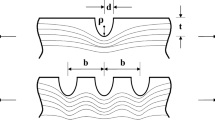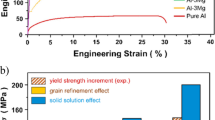Abstract
The friction stir channelling process derives from friction stir welding, where the process itself is modified in order to produce sub-surface channels by removing material from the bulk of the workpiece and leaving its upper surface closed and at the same level it had before being processed. In the present study, sub-surface friction stirred channels were produced on rolled plates of AA5083-H111. Channels’ metallography and morphology were characterized using optical, scanning electron and confocal laser scanning microscopy. The microhardness profile at mid-thickness between the channel top and the upper processed surface, perpendicular to the channelling direction, was determined and the influence of the friction stir channelling process parameters on the microhardness distribution, near the channel, was assessed. It was observed that, the channel inner surfaces are topographically different: the retreating side is rougher than the advancing side and the channel bottom is smoother than its top inner surface. The average microhardness in the dynamically recrystallized zone (nugget), thermo-mechanically affected zone and heat affected zone is lower than that of the unprocessed base material. It was also found that the average microhardness of the nugget is not very sensitive to the tool rotation speed variation.

























Similar content being viewed by others
References
Mishra RS. Integral channels in metal components and fabrication thereof, Patent no. US 6923362 B2, August 2, 2005
Gandra J Method and apparatus for creating channels in workpieces, Patent no. WO2018/083438 A1, 2018
Vidal C, Vilaça P (2011) Processo de Abertura de Canais Internos Contínuos em Componentes Maciços Sem Alteração da Cota de Superfície Processada e Respectiva Ferramenta Modular Ajustável, PT 105628(B)
Vidal C, Infante V, Vilaça P (2015) Characterisation of fatigue fracture surfaces of friction stir channelling specimens tested at different temperatures. Eng Fail Anal 56:204–215, ISSN 1350-6307. https://doi.org/10.1016/j.engfailanal.2015.02.009
Balasubramanian N, Mishra RS, Krishnamurthy K (2009) Friction stir channeling: characterization of the channels. J Mater Process Technol 209(8):3696–3704, ISSN 0924-0136. https://doi.org/10.1016/j.jmatprotec.2008.08.036
Vidal C, Infante V, Vilaça P (2014) Fatigue assessment of friction stir channels. Int J Fatigue 62:77–84, ISSN 0142-1123. https://doi.org/10.1016/j.ijfatigue.2013.10.009
Balasubramanian N, Mishra RS, Krishnamurthy K (2011) Process forces during friction stir channeling in an aluminum alloy. J Mater Process Technol 211(2):305–311, ISSN 0924-0136. https://doi.org/10.1016/j.jmatprotec.2010.10.005
Vidal C, Infante V, Vilaça P (2014) Fatigue behaviour at elevated temperature of friction stir channelling solid plates of AA5083-H111 aluminium alloy. Int J Fatigue 62:85–92, ISSN 0142-1123. https://doi.org/10.1016/j.ijfatigue.2013.10.012
Vidal C, Infante V, Vilaça P (2013) Effect of microstructure on the fatigue behavior of a friction stirred channel aluminium alloy. Proc Eng 66:264–273, ISSN 1877-7058. https://doi.org/10.1016/j.proeng.2013.12.081
Vidal C et al (2013) Metallographic characterization of friction stir channels. Mater Sci Forum 730-732:817–822. https://doi.org/10.4028/www.scientific.net/MSF.730-732.817
Rashidi A, Mostafapour A, Salahi S, Rezazadeh V (2013) Modified friction stir channeling: a novel technique for fabrication of friction stir channel. Appl Mech Mater 302:365–370
Pandya S, Mishra RS, Arora A (2019) Channel formation during friction stir channeling process — a material flow study using X-ray micro-computed tomography and optical microscopy. J Manuf Process 41:48–55. https://doi.org/10.1016/j.jmapro.2019.03.021
Peel M, Steuwer A, Preuss M, Withers PJ (2003) Microstructure, mechanical properties and residual stresses as a function of welding speed in aluminium AA5083 friction stir welds. Acta Mater 51:4791–4801
Acknowledgements
The authors would like to acknowledge the Portuguese Foundation for the Science and Technology (FCT) for its financial support through the PhD scholarship FCT SFRH/BD/62963/2009, project UID/EMS/50022/2019 and project UID/EMS/00667/2019.
Data availability’ statement
The raw/processed data required to reproduce these findings cannot be shared at this time as the data form part of an ongoing study.
Author information
Authors and Affiliations
Corresponding author
Additional information
Publisher’s note
Springer Nature remains neutral with regard to jurisdictional claims in published maps and institutional affiliations.
Rights and permissions
About this article
Cite this article
Vidal, C., Infante, V. & Vilaça, P. Metallographic and morphological characterization of sub-surface friction stirred channels produced on AA5083-H111. Int J Adv Manuf Technol 105, 2215–2235 (2019). https://doi.org/10.1007/s00170-019-04459-7
Received:
Accepted:
Published:
Issue Date:
DOI: https://doi.org/10.1007/s00170-019-04459-7




